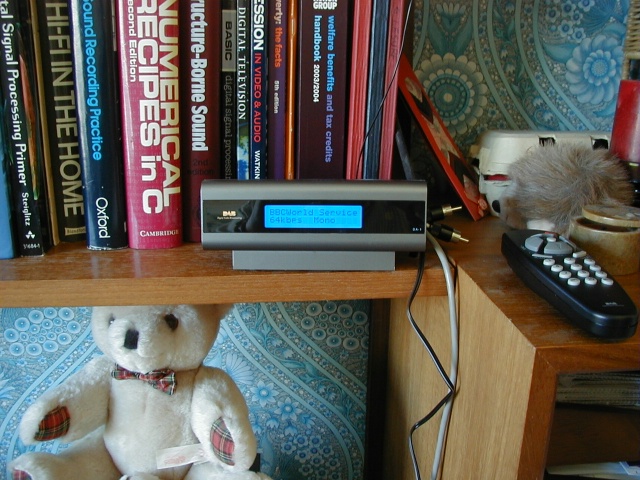This is an expanded and updated version of an article originally published
in the April 2007 issue of Hi Fi News magazine.
My experience with DTTV made me want to be able to hear stations like the BBC World Service in other rooms around the house. Hence when I saw a cheap ‘DAB adaptor’ for sale in a local shop I bought one on impulse and gave it a try. I used this in a background listening system I’ve put together in the room where I tend to write articles like these. This system already included an FM tuner that I’d been happy listening to for many years. So adding the DAB adaptor gave me the chance to compare FM vs DAB, and choose whichever I preferred.
I was quite surprised to find that after a few months I was regularly preferring to listen to R3 via the DAB adaptor rather than via FM. Admittedly, this was comparing two items that weren’t exactly at the peak of contemporary audio. The FM receiver is in an old Armstrong 626 receiver, made some decades ago. The DAB Adaptor is a Mitsui DA-1 bought for about £30. You should be able to tell from this that I wasn’t expecting too much from DAB at the time!
 Picture of the cheap DAB Adaptor and its remote control
Picture of the cheap DAB Adaptor and its remote control
along with books and a teddy bear to give some idea of size.
The sound quality on many DAB stations was as I’d been warned – in the range from ‘mediocre’ to ‘dire’. However on BBC R3 it often sounded quite good to me. This lead eventually to my buying a Pure 701ES DAB tuner for use with my main audio system. It also set me wondering about why I generally preferred R3 on DAB to on FM, despite DAB bitrate concerns.
At the time [early 2006] when I did these comparisons DAB R3 tended to use 192kbps almost all of the time while other DAB stations used 128kbps or less. Figure 1 shows the bitrates generally then used on the BBC DAB multiplex. It also shows the bitrates some years earlier - before the BBC decision to go for ‘width’ in terms adding extra stations instead of ‘quality’ by preserving the bitrate for each. As you can see, popular stations like BBC R1 lost out in this process rather more than R3. However around the start of the Proms in 2006 – i.e. after I’d written the original article – the BBC suddenly reduced the bitrate on R3 to 160kbps. The result was quite dire, and prompted a great deal of angry complaints. Particularly because for most of the time the BBC were using the ‘stolen’ bitrate to run a rolling trailer for a station that wasn’t on-air! One consequence was that the first weeks of Prom broadcasts on DAB that year sounded awful. After initially trying to dismiss the criticisms and pretend that the sound quality hadn’t suffered, the BBC finally relented and R3 on DAB reverted to mainly using 192kbps. One curious feature of this period was that although Classic FM were also using 160kbps their output didn’t sound as poor as DAB R3 did during this period. This raises the curious possibility that either some other settings/details of the encoding process was being badly done by the BBC, or that sounds with a wide dynamic range are more seriously affected by low bitrates...
However after spending a lot of time switching back and forth I decided that when R3 was being transmitted at 192kbps the data reduction on DAB wasn’t actually the main cause of the differences I felt could hear between FM and DAB. What was most obvious was that DAB had an audibly wider dynamic range with less background noise than on FM.








